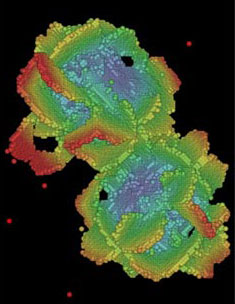Robert Rudd, Jim Belak, Laurent Dupuy and Eira Seppälä
Atoms forming dislocations as two voids coalesce. Here is a movie showing an ASC simulation of the atomic level deformation of copper around a growing void. Void growth and coalescence are known to be the microscopic mechanism of fracture in ductile metals like copper. The goal of these simulations is to characterize how the material must deform to accommodate the growing void(s). These simulations consist of a cube of single crystal copper with periodic boundary conditions and one or more small voids present initially in the material. The size of the box was then increased, inducing a tensile stress, at a rate comparable to the strain rate in tensile (release) shock waves. The movie shows only those atoms that are doing something interesting: the atoms on the surface of the void and those in crystal defects associated with the deformation. These defects, known as dislocations, form on the surface of the void and propagate away as loops. The loops appear as parallelograms in the movie. The coloring indicates the distance from the center of the void. The loop mechanism transports atoms away from the void allowing it to grow.
We have modeled the nucleation, growth and coalescence of voids inherent to dynamic fracture using atomistic and multiscale simulations. The nucleation and growth of voids governs the initial phase of fracture at high strain rate in ductile metals. The processes of void growth and coalescence span many length scales, from void formation at the nanoscale to void linkage and fracture at the macroscale. This work has examined the processes of plasticity associated with void growth at the nanoscale. As a void grows, the material surrounding the void deforms plastically in order to accommodate the increasing void size. We have used a new dislocation analysis technique to characterize the dislocation activity on the fly in dynamic, finite temperature simulations. The result is a detailed picture of how dislocation loops are punched out from the surface of the void, including a complete analysis of the Burgers vectors and glide directions. Depending on the shape of the void and the applied stress, some fraction of the loops propagate ballistically at speed approaching the shear wave velocity.
Selected Publications
- E.T. Seppala, J. Belak and R.E. Rudd, "The Onset of Void Coalescence during Dynamic Fracture of Ductile Metals," Phys. Rev. Lett. 93, 245503 (2004).
- E.T. Seppala, J. Belak and R.E. Rudd, "Three-dimensional molecular dynamics simulations of void coalescence during dynamic fracture of ductile metals," Phys. Rev. B 71, 064112 (2005).
- E.T. Seppala, J. Belak and R.E. Rudd, "Effect of stress-triaxiality on void growth in dynamic fracture of metals: a molecular dynamics study," Phys. Rev. B 69, 134101 (2004).
- J. Belak, "Multi-scale applications to high strainrates dynamic fracture," J. Comp.-Aided Mater. Design 9, 165-172 (2002).
- R.E. Rudd and J. Belak, "Void Nucleation and Associated Plasticity in Dynamic Fracture of Polycrystalline Copper: An atomistic simulation," Comput. Mater. Sci. 24, 148-153 (2002).
- J. Belak, "On the nucleation and growth of voids at high strain-rates," J. Comp.-Aided Mater. Design 5, 193 (1998).





